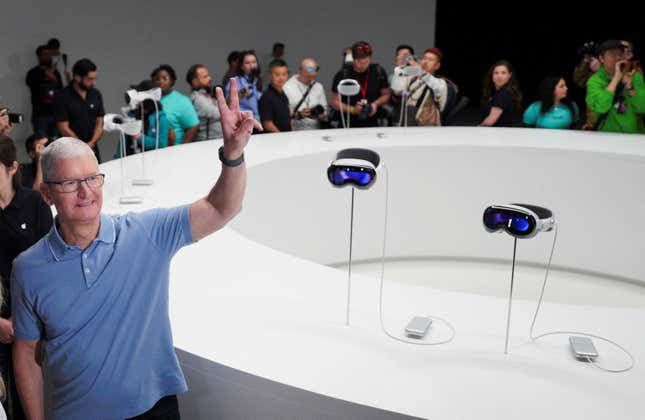
After years of speculation, Apple officially released its version of a virtual and augmented reality headset called the Apple Vision Pro. Dubbing the product a “spatial computer,” and strategically avoiding the word metaverse, Apple CEO Tim Cook introduced the device at the company’s Worldwide Developers Conference (WWDC) in Cupertino, California.
Cook’s presentation showed various uses for the Vision Pro, including immersive movie-watching, video games, and simple computer tasks like accessing an internet browser. Apple claims that users will be able to intuitively control the device with eye contact, as well as through hand motions and voice dictation.
The company plans to adapt hundreds of apps from the iOS app store for the headset, including an updated version of FaceTime that will create an avatar of the user’s face and create a “persona” for video conferencing.
The Vision Pro will be available in the US in early 2024 and in other countries later next year.
How much does the Apple Vision Pro cost?
The glasses are sleek and noticeably slimmer than competing headsets, but still come with some limitations inherent to the emerging technology. The headset’s battery only lasts roughly twohours—similar to the battery life of the popular Meta Quest headset—and is still mainly a vehicle for apps designed for the flat screens of laptops and phones.
The main difference from competitors is the Vision pro’s eye-popping price. Apple confirmed the headset will cost $3,499, well above the current $999 price tag for the top-line Meta Quest model. The decision is in line with Apple’s familiar strategy to lean on its brand loyalty and offer products at a higher price than its competitors.
Disney CEO Bob Iger made a surprise appearance at the conference, announcing that the media company would include Disney+ capability in the headset, as well as allow users to visit a virtual Disney World on their headsets.
The biggest winner of Apple’s announcement? Unity Software
Stock for Unity Software, a 3D software and gaming company, rose by 17% following Apple’s announcement that Unity’s video gaming technology would be used in the Apple Vision Pro headset. It was the stock’s biggest single jump since it declared an IPO in 2020, and led to a brief halt in Unity trading.
“We know there is a community of developers who have been building incredible 3D apps for years,” Apple’s vice president of worldwide developer relations Susan Prescott said at the WWDC conference.
“Today, we are excited to share that we’ve been working with Unity to bring those apps to Vision Pro, so popular Unity-based games and apps can gain full access to VisionOS features such as Passthrough, high-resolution rendering and native gestures.”
Apple stock was not quite as reactive, up just 1.45% at the market’s close after hitting an all-time high earlier in the day.
Related stories
Apple WWDC 2023 is where the new virtual reality headset rumors face a reality test
Virtual reality could be a solution to sexism in tech
Soon you might not need an expensive computer to lose yourself in immersive VR worlds